Trap-neuter defeats legal challenge

IN FEBRUARY, Albuquerque marked a special milestone for those of us who support feral colonies and the management model known as trap-neuter- release. Two years had passed for the city’s Community Cats Project— a public-private partnership between the Animal Welfare Department, Best Friends Animal Society, and PetSmart Charities— without a single cat being killed just because it was feral.
Since the program launch in January 2012, nearly 9,800 cats had been sterilized and vaccinated. Intake of cats and kittens at shelters had declined by 39 percent, and euthanasia of cats at shelters had decreased by 88 percent.
Perhaps most significant, the number of kittens 8 weeks or younger entering the city’s shelter system had fallen by nearly a third — an obvious indicator that the overall population of community cats was declining.
Soon after this milestone, the project was hit with a lawsuit by opponents of TNR. The suit alleged that by returning cats to their outdoor homes, the city was in violation of anti-cruelty laws prohibiting animal abandonment. This also implied that the people involved in Community Cats had an intent to do harm, or knowledge that the cats would likely come to harm.
Opponents of TNR such as People for the Ethical Treatment of Animals (PETA), the American Bird Conservancy, and others have used false statistics, fear mongering, and high-dollar PR campaigns to convince municipalities that the only way to manage these creatures is to exterminate them all. When the accusation of animal cruelty was brought, project supporters were ready with facts and undeniable success stories. At every hearing, supporters like the Best Friends Animal Society, Alley Cat Allies, and the ASPCA—along with managers of cat communities and no-kill shelters—spoke eloquently on behalf of the cats and offered to provide training, education, and grants to communities willing to start their own programs.
TNR is the farthest thing from animal cruelty. It is a humane and well-thought-out approach to animal management that not only saves lives, but money. It organizes those of us who participate in setting up cat communities, and enlists veterinarians and no-kill shelters to offer low- or no-cost sterilization and wellness visits—all with the explicit goal of reducing the number of cats on the street.
With education and support, a colony can double the life of feral cats while reducing the overall cat population and improving the health and happiness of multigenerational ferals.
In October, TNR supporters were rewarded for their efforts when 2nd District Court Judge Alan Malott dismissed the legal challenge to Albuquerque’s Community Cats Project. Albuquerque’s Animal Welfare Department noted: “It is a mainstream approach, highly recommended by experts such as the ASPCA. The only other alternative is to euthanize thousands of cats annually which we do not think is humane or effective.”
One of the most important aspects of TNR is training and a plan for what needs to happen after the cats are released. Once feral populations are controlled, then the real work begins. Albuquerque is far from alone in its shift in management of feral cats. Opponents will most likely continue to target other community programs, but we have found our footing and will follow wherever they go.
The no-kill model works. It does take time, but can we as a species honestly choose death for thousands of creatures over slow progressive management? Are we that lazy and disconnected? Just as we are learning that animals have senses and abilities we never dreamed of, how can some continue to say, “They are only cats”?
Kat Brown of Albuquerque is a lifelong animal-lover, especially of cats. Share your cat stories or comments at katskorner88@gmail.com.
